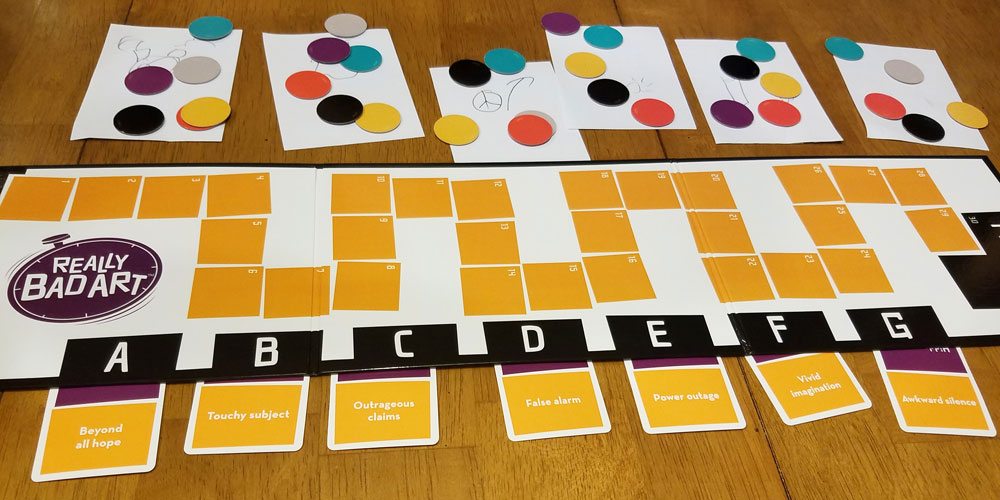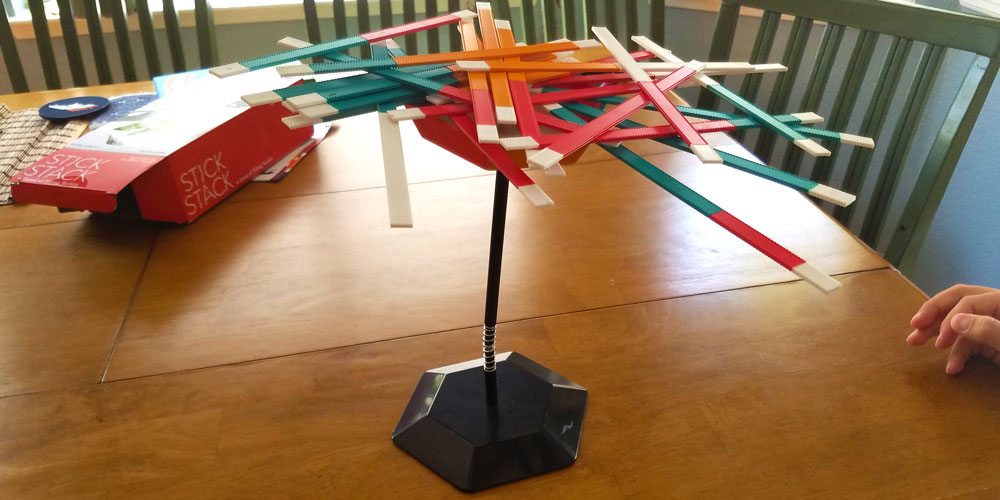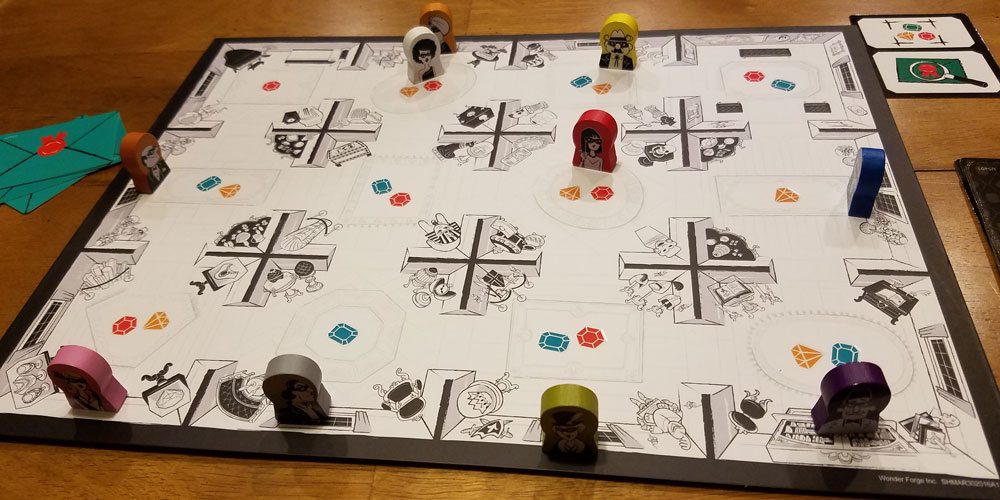
At our Gaming with GeekDad event at Gen Con, the nice folks from Forrest-Pruzan Creative, a Seattle-based design firm, showed up with the three titles they have designed as Target exclusives. We played one with the team at the conference, but then they said that one of us could take all three games home to try them out. I volunteered, and I’m quite glad that I did as all three games have turned out to be family favorites.
All three games can be found at your local Target store or online at Target.com.
Really Bad Art

The game we played with the designers at Gen Con was Really Bad Art, which they described, accurately, as a mix between Pictionary and Dixit. In the game, each player (it supports up to 6) gets a card with a word or phrase on it, which they keep hidden and cannot look at yet. Then, in the Pictionary phase, one player starts an electronic timer that comes with the game, and each player looks their card and draws, or rather attempts to draw, their word or phrase. Once the timer expires, everyone stops drawing and places their “art” next to the board. That’s followed by the Dixit phase: everyone passes their card, still face down, to one of the players, who draws an additional card from the box (so that there is always one more card available than there are players), mixes them up, and then places them next to the board in spaces labelled A-G. Each player then attempts to guess which drawing corresponds to which word by placing chips with matching letters on them. Once everyone is done, the chips are revealed. Players score two points for correctly guessing someone else’s drawing, and one point for each other player who guess their own.
Sound easy? Well, there are two minor catches. First, the words aren’t things like “cat” or “Eiffel Tower”. Rather, they are more abstract concepts like “twist of fate” or “what’s done is done”. So those would be hard enough to draw alone, but the second thing, the thing that makes the game both hilarious and really difficult, and results in no one questioning the game’s name, is that the timer is for six seconds. That’s right: you have to look at this abstract phase, figure out how to draw it, and then draw it, all in just six seconds. That’s roughly as long as it probably took you to read that last sentence.
It’s a really fun party game that gets everyone laughing. I introduced it to my family a few nights ago, and the kids have asked to play it again each evening since. The game retails for $19.99.
Stick Stack

Of these three games, this was the one that looked the least interesting to me at Gen Con, and the one I was the most wrong about. Stick Stack is a dexterity game of balancing sticks on top of a very unstable platform. The platform is a multi-colored hexagon, which is connected to a base via a stand with a spring that allows it to tilt a considerable distance in any direction. The game is very straight-forward: each player draws a stick from a bag and then attempts to balance it on the platform without causing it or any of the other sticks to drop. What makes this game unique from others in the category is that the sticks are made up of a combination of white, green, orange and red sections, and when placing the stick, colors can only match like colors. In other words, if you have a stick that is 60% red and 40% orange, it must be placed so that the red part only touches red parts of other sticks or of the platform, and the orange part only touches orange. This makes things a lot more difficult than at first glance, and inevitably leads to most of the sticks getting stacked to one side, causing the platform to slowly tilt to that side until that final stick that causes the whole thing to collapse.
The rules outline a scoring system: any sticks that fall off on a player’s turn remain in front of that player and can be used in future turns, but if they’re still then when the whole stack falls over, that player gets a point for each remaining stick. The player who caused the collapse takes four points, and the first player to reach eleven points loses. That’s fine, I guess, but we decided very quickly to skip the scoring system and just have fun trying to stack the sticks.
The kids have wanted to play this pretty much non-stop. Our games have lasted an average of five or ten minutes, although technically that’s more like a round if you follow the scoring. The game retails for $16.99.
Suspicion

At first glance, Suspicion looks a lot like Clue, but once you get into it you realize that it’s really an entirely different game. In Suspicion, players take on the role of an international jewel thieves who have been invited to a rich person’s house for some party or something. It doesn’t really matter. After placing all ten of the player tokens on the board (the game can be played by 2-6 players, so there will always be more tokens than players), players are dealt an invitation card, which they look at but keep secret from the other players. This card reveals to the player which character they are. Players also get a set of “yes” and “no” cards, and two cards from the Action deck.
On their turn, players roll two six-sided die that show the characters on the board, along with two wild card spots. The player then moves the two tokens from the die into adjacent rooms. The wild cards allow them to move any character they want. Following that, they can play one of their two cards, taking one of the two actions printed on the card. These cards allow them to steal gems–the ultimate goal of the game–or perform actions that help them figure out the identity of other players. Play continues until one of the three jewel stacks is empty, at which point everyone tallies their score to determine a winner. Points are awarded both for the number and types of gems players collect and for correctly figuring out the identity of other players.
There’s a surprising level of strategy in the game, where you have to balance achieving your goals with hiding your identity. For instance, one of the actions allows you to collect a gem, but only from the gems shown on the board in the room your character is currently in. So you have to be careful, because other players can immediately mark off all of the characters who are in rooms without that kind of gem. It’s possible, though, to manage the movement of the other pieces to minimize this risk; in one game we played, I was able to move the pieces around such that taking a jewel didn’t give any information to the other players.
Our first game was long–about two hours–but that was mostly because we got too invested in trying to figure out who everyone else was and forgot to collect jewels, which is what triggers the end game. Another game I played with my son and his friend lasted only about a half hour, which I suspect is much more in the normal range.
The game retails for $19.99.

We love Really Bad Art, too. It’s great for a party or family fun night. Some of the phrases are bit over my 9-year-old’s head, so we just let her look at the card and see if she understands. If not, she puts it back and pulls another one. It works with the spirit of the game, and doesn’t really impact the outcome much.